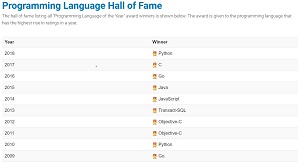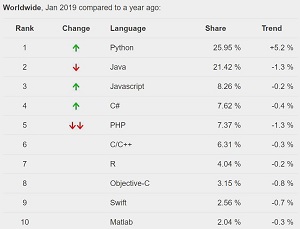News
Popularity Index: Python Is 2018 'Language of the Year'
- By David Ramel
- January 8, 2019
Python continued its rise in the TIOBE index of programming language popularity, clocking in at No. 3 in the January 2019 report and being named programming language of the year for 2018. Python also ended the year as No. 1 in the PYPL index.
Though it still sits below perennial mainstays Java and C, it was named 2018's top programming language based on its percentage change in the rankings.
"Python is everywhere," summarized TIOBE in its "TIOBE Index for January 2019."
TIOBE actually cracked the top 3 for the first time last September. Forecasting that ascension in the August report, TIOBE said, "So it is very likely that Python will enter the top 3 and even might become the new number 1 in the long run."
While that hasn't happened yet, it may be in the works as the language is adopted by more programmers because of its ease of use and general utility.
 [Click on image for larger view.]
Last 10 Champs (source: TIOBE)
[Click on image for larger view.]
Last 10 Champs (source: TIOBE)
"Python has now definitely become part of the big programming languages," TIOBE said yesterday in its January 2019 report. "For almost 20 years, C, C++ and Java are consistently in the top 3, far ahead of the rest of the pack. Python is joining these 3 languages now. It is the most frequently taught first language at universities nowadays, it is number one in the statistical domain, number one in AI programming, number one in scripting and number one in writing system tests. Besides this, Python is also leading in web programming and scientific computing (just to name some other domains)."
The language is also on the rise in other popularity indices. For one example, in the annual IEEE Spectrum ranking, Python retained its No. 1 position in the publication's annual report published in August. The publication offered two reasons to explain why Python continues to gain programmer mindshare. One is that it's now listed as an embedded language, taking advantage of higher-power modern hardware that lets microcontrollers more easily host a Python interpreter, whereas embedded programming used to favor compiled languages. The second reason is the decline of stats/Big Data specialist R.
Another programming language index, the "PYPL PopularitY of Programming Language," also has Python at No. 1 for the year, followed by Java and JavaScript. Its criteria includes how often language tutorials are searched on Google.
 [Click on image for larger view.]
PYPL PopularitY of Programming Language (source: PYPL)
[Click on image for larger view.]
PYPL PopularitY of Programming Language (source: PYPL)
In other highlights of the TIOBE January 2019 report, Visual Basic .NET experienced the second-most growth beyond Python, powering it to No. 5 in the latest report, a gain of two spots. Languages experiencing the biggest percentage drops included R, Delphi/Object Pascal, Ruby and Visual Basic.
Faring better were languages such as MATLAB, Rust, Julia, TypeScript and newcomer Kotlin, which is making big inroads on Java in Android mobile programming. "Let's do one prediction for 2019," TIOBE said, "Kotlin will enter the top 20. We see a fast adoption in the industrial mobile app market of this language."
This month also saw the addition of WebAssembly, brand-new technology that serves as assembly-like bytecode for Web development, providing a portable compilation target for high-level languages such as C/C++/Rust and, in the Microsoft camp, C# via the Blazor project. WebAssembly debuted at No. 192.
The definition of the TIOBE index, which is based on search engine results, can be found here.
About the Author
David Ramel is an editor and writer at Converge 360.